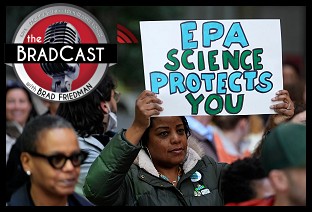 Gov. Jerry Brown's decision to mandate a 25% reduction of urban water use in California was absolutely necessary and woefully inadequate.
Gov. Jerry Brown's decision to mandate a 25% reduction of urban water use in California was absolutely necessary and woefully inadequate.
The unprecedented mandatory restriction is necessary because the state faces an historically acute and potentially catastrophic shortage of freshwater. Newly released NASA data suggests the state could run out of surface water reserves completely within the next year.
The severe water shortage, however, is not merely acute. It is chronic. The Golden State is now in its fourth year of an extreme, global climate change-linked drought that scientists predict could continue for decades.
There are a multitude of reasons why Brown's overly simplistic 25% urban water use reduction --- a meager 6.25% of water consumption by all sectors of the California economy --- is woefully inadequate when measured against both acute and chronic extreme drought conditions...
Why exempt major water polluting consumers?
 In light of the fact that urban use accounts, at best, for just 20% of California's total water consumption (agricultural interests consume about 80%) it is somewhat striking, if not alarming, that Brown exempted the fossil fuel industry, factory farming and industrial livestock from the newly announced mandatory restrictions.
In light of the fact that urban use accounts, at best, for just 20% of California's total water consumption (agricultural interests consume about 80%) it is somewhat striking, if not alarming, that Brown exempted the fossil fuel industry, factory farming and industrial livestock from the newly announced mandatory restrictions.
"The electricity industry," according to Sandia National Laboratories, "is second only to agriculture as the largest user of water in the United States. Electricity production from fossil fuels and nuclear energy requires 190,000 million gallons of water per day, accounting for 39% of all freshwater withdrawals in the nation."* Additionally, the GRACE Communications Foundation notes, "it is estimated that the United States withdraws 1 to 2 billion gallons of water to refine nearly 800 million gallons of petroleum products every day."
In an email to The BRAD BLOG, Dr. Yoram Cohen of UCLA's Water Technology Research Center cautions that the 39% of freshwater withdrawals the fossil fuel and nuclear energy industries are responsible for may not equate to "consumptive use." Water used for power plant cooling is often returned to its original source.
Still, fossil fuel storage and extraction, factory farming and industrial livestock practices do more than simply use and/or consume large quantities of water. These industries contaminate aquifers, turning precious supplies of fresh groundwater into a toxic soup of carcinogenic chemicals, bacteria and brackish groundwater that is unfit for either farming or human consumption.
We are not dealing with small numbers.
Per a 2000 EPA study, factory farming and industrial livestock practices account for 48% of stream and river water pollution and 41% of lake water pollution. According to the National Resources Defense Council (NRDC), California officials identified agriculture and livestock as "the major source of nitrate pollution in more than 100,000 square miles of polluted groundwater." Algal blooms associated with animal waste contributed to an 8,500 square mile "dead zone" in the Gulf of Mexico. Those algal blooms result not only from direct contamination, like that which occurred in 2012, as the NRDC notes, when "a California dairy left over 50 manure covered cow carcasses rotting around its property and polluting nearby waters." Waste disposal also produces ammonia gas that, they say, "can be carried more than 300 miles through the air before being dumped back onto the ground or into water."
Recently, Gov. Brown defended the controversial oil extraction technique known as hydraulic fracturing ("fracking"). In California, he asserted, the industry deploys "vertical fracking" that is far less water-intensive than the "horizontal" method deployed elsewhere.
But as environmentalist Claire Sandberg argues at Truthout, there are reasons to be skeptical of Brown's effort to minimize the amount of water consumed by fracking in California. "The state Division of Oil, Gas, and Geothermal Resources (DOGGR) has not tracked fracking activity comprehensively," Sandberg writes, "so the extent of the practice is hard to quantify."
Irrespective of the actual fracking water consumption numbers, there can be no room for doubt that fracking and other irresponsible, fuel industry extraction and storage practices can lead to massive groundwater contamination. The process entails re-injection of fracking waste liquid, known as "flowback fluid," into underground aquifers. Testing results from hundreds of water wells in the state recently revealed the presence of the carcinogen, benzene, at levels 700 times greater than federal safety standards allow.
Earlier this year, the L.A. Times reported, eight California lawmakers called upon Gov. Brown to "shut down 2,500 oil production and waste water wells" that had contaminated "protected aquifers" in violation of the federal Clean Water Act.
The 'supply side'
 This is not to suggest that Brown should have mandated a flat 25% reduction of water use by all sectors of the California economy --- a somewhat arbitrary number that gives rise to false Hobson's choices.
This is not to suggest that Brown should have mandated a flat 25% reduction of water use by all sectors of the California economy --- a somewhat arbitrary number that gives rise to false Hobson's choices.
We do not have to choose between food and water. There are a multitude of methods that can be deployed to minimize agricultural water consumption. These include increasing irrigation efficiency, soil management, water recycling, and organic farming. In semi-arid Israel, for example, agricultural use of drip irrigation reduced water consumption by 50-70% as compared with gravity irrigation and 10-20% compared with sprinkler irrigation.
Conservation only deals with the demand side of the water equation.
Faced with severe drought, the Texas Water Development Board commissioned an "innovative water technologies" study which located 880 trillion gallons of brackish groundwater within thirty designated aquifers. "If converted to freshwater," the study concluded, "that amount of water could maintain Texas' current water consumption levels for 150 years." As of 2014, Texas had erected 34 municipal brackish groundwater desalination plants that provide 73 million gallons of potable water per day.
The knock on seawater desalination plants, like the $1 billion Carlsbad Desalination Project that is expected to furnish 7% of San Diego County's water requirements, is that they are inordinately expensive and energy intensive. High energy and costs arise because seawater contains a higher salt content than California's abundantly available brackish water and because those facilities deploy traditional "reverse osmosis."
Israeli engineers have developed far more energy efficient desalination technology. Researchers at Lawrence Livermore National Labs and Stanford are developing breakthrough techniques that require "little equipment or energy" and "could be scaled to fit any need: from portable personal devices to city water treatment."
The net efficiency of all desalination facilities would be greatly improved if those plants abandoned water intensive and environmentally destructive fossil fuel power in favor of zero water consuming, clean energy technologies, like photovoltaic solar and wind.
Confronting denial and meeting the challenge
 Our need to more swiftly turn to alternative energy highlights the most significant inadequacy of Brown's scheme to target only urban water usage as a form of drought relief.
Our need to more swiftly turn to alternative energy highlights the most significant inadequacy of Brown's scheme to target only urban water usage as a form of drought relief.
We have failed to fully recognize an "inconvenient truth." Thus, we find the Governor attempting to defend fracking in California on a "we have to get the oil from somewhere" rationalization, rather than coming to grips with scientific warnings that these climate destroying fossil fuels must "stay in the ground."
We've ignored decades of dire warnings from climate scientists. Our political institutions and public airwaves have been utterly compromised by the corrupting influence of a handful of climate science denying billionaires, like Charles and David Koch, who sport a vice-into-virtue philosophy that places the unbridled greed of the privileged few, not only above the needs of the many, but above the need for a sustainable environment that will ensure the survival of our species.
Nonetheless, it's time to act. Far passed it. The 25% urban use reduction is inadequate because it is too narrow and too simplistic.
California should target the agricultural sector, not by a fixed percentage of use reduction but by imposing mandatory utilization of water saving techniques, e.g., drip irrigation, water recycling and organic farming. We should strive to reduce and eventually eliminate contamination of our precious groundwater by the fossil fuel, factory farming and livestock industries. We must look to our academic institutions and science to rapidly seek out additional supplies of freshwater via breakthrough techniques in desalination, all the while striving to replace environmentally destructive energy sources with clean technologies.
Given the exigencies, what is required is nothing less than a massive, scientific undertaking that would rival that formerly devoted to the development of nuclear energy via the Manhattan Project. With 40 million residents, untold billions in agricultural assets and ever increasing energy needs as a potential mega-drought moves north and east towards still more states, its time for California to invest whatever it must to save both the planet and its own future.


 Sunday 'Now Hoarding' Toons
Sunday 'Now Hoarding' Toons Mad World:
Mad World: 'Green News Report' 5/15/25
'Green News Report' 5/15/25
 Plane Corruption and the Future of the DOJ: 'BradCast' 5/14/25
Plane Corruption and the Future of the DOJ: 'BradCast' 5/14/25 'Deeply Evil': GOP Proposes Largest Medicaid Cuts in History: 'BradCast' 5/13/25
'Deeply Evil': GOP Proposes Largest Medicaid Cuts in History: 'BradCast' 5/13/25 'Green News Report' 5/13/25
'Green News Report' 5/13/25 And Then They Came for the Mayors...: 'BradCast' 5/12/25
And Then They Came for the Mayors...: 'BradCast' 5/12/25 Sunday 'New Guy, Old Guy' Toons
Sunday 'New Guy, Old Guy' Toons Blowing Smoke. At the Vatican and White House: 'BradCast' 5/8/25
Blowing Smoke. At the Vatican and White House: 'BradCast' 5/8/25 'Green News Report' 5/8/25
'Green News Report' 5/8/25 SCOTUS Weighs Public Funding of Religious Schools: 'BradCast' 5/7/25
SCOTUS Weighs Public Funding of Religious Schools: 'BradCast' 5/7/25 Trump Judge Blocks NC GOP Theft of 2024 Supreme Court Seat: 'BradCast' 5/6/25
Trump Judge Blocks NC GOP Theft of 2024 Supreme Court Seat: 'BradCast' 5/6/25 Prosecutors Quit After U.S Attny Strikes Deal With Felon Cop: 'BradCast' 5/5/25
Prosecutors Quit After U.S Attny Strikes Deal With Felon Cop: 'BradCast' 5/5/25 Trump Losing Streak Continues into SECOND Hundred Days: 'BradCast' 5/1/25
Trump Losing Streak Continues into SECOND Hundred Days: 'BradCast' 5/1/25 100 Daze (w/ Digby and Driftglass): 'BradCast' 4/30/25
100 Daze (w/ Digby and Driftglass): 'BradCast' 4/30/25 Campaign to 'Impeach Trump Again' Gains Fresh Momentum: 'BradCast' 4/29/25
Campaign to 'Impeach Trump Again' Gains Fresh Momentum: 'BradCast' 4/29/25 And Then They Came for the Judges...: 'BradCast' 4/28/25
And Then They Came for the Judges...: 'BradCast' 4/28/25 Trump EPA Guts Enviro Justice Office: 'BradCast' 4/24/25
Trump EPA Guts Enviro Justice Office: 'BradCast' 4/24/25
 VA GOP VOTER REG FRAUDSTER OFF HOOK
VA GOP VOTER REG FRAUDSTER OFF HOOK Criminal GOP Voter Registration Fraud Probe Expanding in VA
Criminal GOP Voter Registration Fraud Probe Expanding in VA DOJ PROBE SOUGHT AFTER VA ARREST
DOJ PROBE SOUGHT AFTER VA ARREST Arrest in VA: GOP Voter Reg Scandal Widens
Arrest in VA: GOP Voter Reg Scandal Widens ALL TOGETHER: ROVE, SPROUL, KOCHS, RNC
ALL TOGETHER: ROVE, SPROUL, KOCHS, RNC LATimes: RNC's 'Fired' Sproul Working for Repubs in 'as Many as 30 States'
LATimes: RNC's 'Fired' Sproul Working for Repubs in 'as Many as 30 States' 'Fired' Sproul Group 'Cloned', Still Working for Republicans in At Least 10 States
'Fired' Sproul Group 'Cloned', Still Working for Republicans in At Least 10 States FINALLY: FOX ON GOP REG FRAUD SCANDAL
FINALLY: FOX ON GOP REG FRAUD SCANDAL COLORADO FOLLOWS FLORIDA WITH GOP CRIMINAL INVESTIGATION
COLORADO FOLLOWS FLORIDA WITH GOP CRIMINAL INVESTIGATION CRIMINAL PROBE LAUNCHED INTO GOP VOTER REGISTRATION FRAUD SCANDAL IN FL
CRIMINAL PROBE LAUNCHED INTO GOP VOTER REGISTRATION FRAUD SCANDAL IN FL Brad Breaks PA Photo ID & GOP Registration Fraud Scandal News on Hartmann TV
Brad Breaks PA Photo ID & GOP Registration Fraud Scandal News on Hartmann TV  CAUGHT ON TAPE: COORDINATED NATIONWIDE GOP VOTER REG SCAM
CAUGHT ON TAPE: COORDINATED NATIONWIDE GOP VOTER REG SCAM CRIMINAL ELECTION FRAUD COMPLAINT FILED AGAINST GOP 'FRAUD' FIRM
CRIMINAL ELECTION FRAUD COMPLAINT FILED AGAINST GOP 'FRAUD' FIRM RICK SCOTT GETS ROLLED IN GOP REGISTRATION FRAUD SCANDAL
RICK SCOTT GETS ROLLED IN GOP REGISTRATION FRAUD SCANDAL VIDEO: Brad Breaks GOP Reg Fraud Scandal on Hartmann TV
VIDEO: Brad Breaks GOP Reg Fraud Scandal on Hartmann TV RNC FIRES NATIONAL VOTER REGISTRATION FIRM FOR FRAUD
RNC FIRES NATIONAL VOTER REGISTRATION FIRM FOR FRAUD EXCLUSIVE: Intvw w/ FL Official Who First Discovered GOP Reg Fraud
EXCLUSIVE: Intvw w/ FL Official Who First Discovered GOP Reg Fraud GOP REGISTRATION FRAUD FOUND IN FL
GOP REGISTRATION FRAUD FOUND IN FL

































